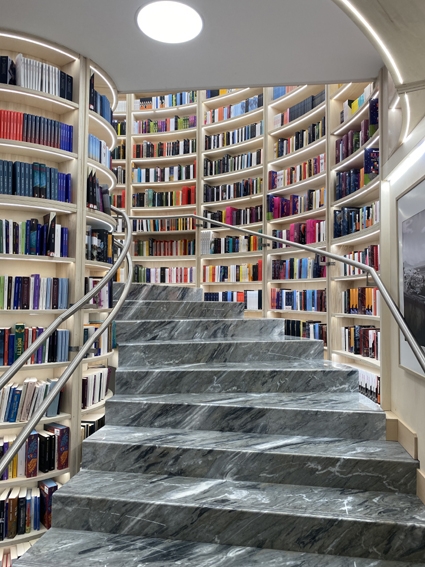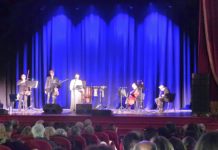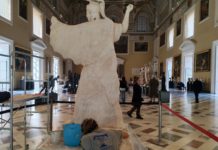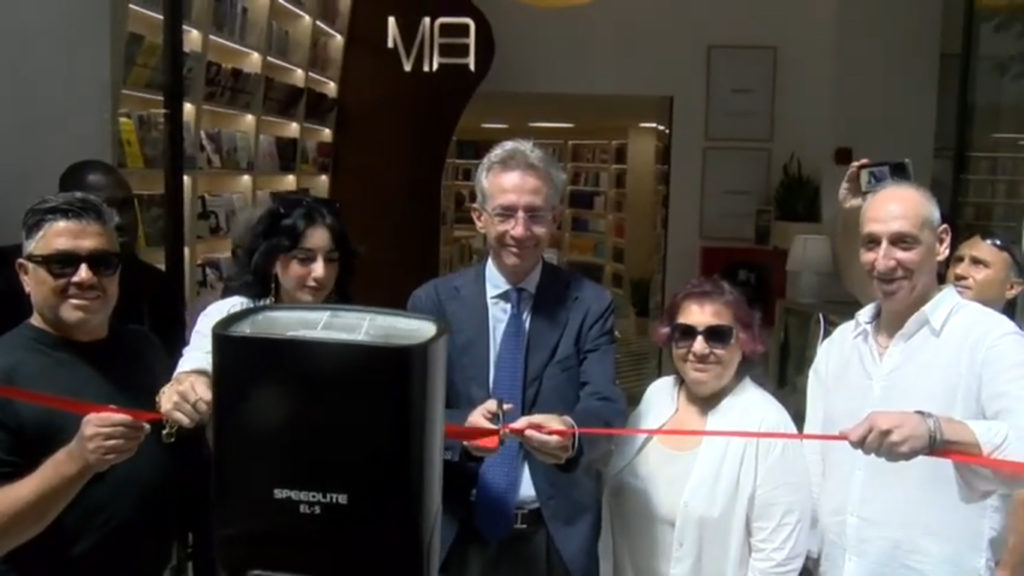
L’apertura della Libreria Mondadori è un evento attesissimo in città dopo che l’inaugurazione del 17 maggio era stata seguita dalla chiusura del 18 perché non c’erano tutti i permessi necessari. Finalmente dopo due mesi si sono ottenute le dovute autorizzazioni e il nuovo inizio è fissato per il 5 agosto alle 10.30. Sono un po’ indeciso se partecipare all’evento poi con una telefonata il mio amico Gianni mi sprona ad andare.
Quando arrivo, ad attendere il taglio del nastro rosso, messo sulla porta di accesso, ci sono molte persone, in massima parte cronisti e teleoperatori. La vetrina posta accanto alla porta di ingresso consente di sbirciare l’interno e i tanti libri esposti vicini al vetro, sia quelli accumulati a formare dei parallelepipedi di uno stesso autore che quelli disposti su una libreria a forma di scala a chiocciola che si solleva leggera nell’aria verso l’alto.
L’interno del locale è accattivante e invita a entrare succede lo stesso con i libri: la loro copertina cerca di stuzzicare il lettore a varcare quel passaggio per viaggiare tra i fogli.
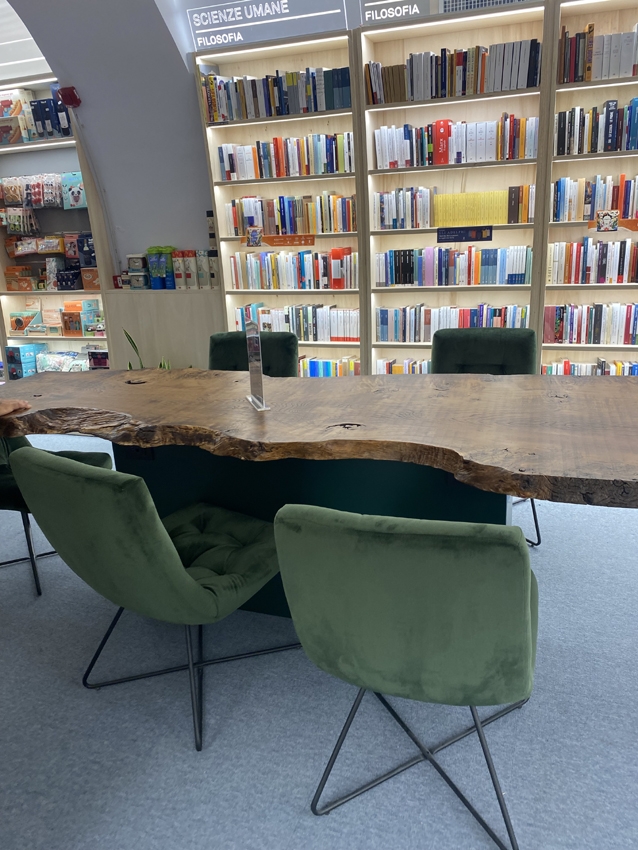
Guardando alla scrittura dei titoli, posta sui testi in esposizione, penso alla meraviglia di questa scoperta: una rappresentazione del linguaggio attraverso dei segni che permette di comprendere per chi legge le intenzioni di chi scrive. Anche quando chi scrive non c’è più e fa parte del passato la parola scritta gioca un ruolo essenziale per conoscere il suo pensiero e comprendere il passato in cui è vissuto. Quei segni sono una relazione che ci unisce al passato ma anche un legame che documentano la nostra storia.
Altre volte le parole più che a documentare fatti o avvenimenti stimolano la fantasia per regalarci sogni o evocare emozioni. Quante cose conservano questi scrigni misteriosi che sono i libri capaci di costruire mondi speciali molto più articolati delle più complesse ricostruzioni virtuali.
Ho letto ultimamente che per conquistare il proprio interlocutore servono solo 7 secondi perché secondo questa indagine le informazioni trasmesse al nostro cervello sono di natura visiva e le immagini vengono elaborate 60.000 volte più velocemente nel nostro cervello rispetto alle parole. Non so se questo sia uno dei motivi importanti che portano le persone oggi a preferire le immagini alla lettura. Di sicuro quando ci si allontana dalla parola scritta non si riesce neanche a leggere le immagini: si finisce per sfogliare le foto velocemente soffermandosi su quelle che riescono a catturare la nostra attenzione.
Leggere è faticoso e spesso alcuni siti per invogliare al brano inseriscono i minuti necessari per la lettura come se ci fosse un tempo preciso nella relazione che ciascuno di noi ha con un testo.
Il problema che probabilmente caratterizza la nostra epoca è la sensazione di non avere tempo. In questo modo viviamo male l’attimo presente, e, senza accorgercene, perdiamo la possibilità di vivere il nostro tempo.
Abbiamo superato quasi di un’ora l’orario previsto per l’apertura e finalmente con l’arrivo del sindaco Gaetano Manfredi si può procedere con l’inaugurazione. La libreria Mondadori della Galleria Umberto che viene presentata come bookstore, faccio spesso un po’ fatica a capire la necessità di un termine inglese, presenta una superficie di 1.000 metri quadrati ed un’offerta di 148.000 volumi.
Ci sono volumi di narrativa, saggistica e poi tante sezioni come quella dedicata ai libri per bambini con giochi didattici e fiabe illustrate per stimolare la fantasia dei più piccoli o l’innovativo reparto dedicato al fenomeno dei manga e dei fumetti.
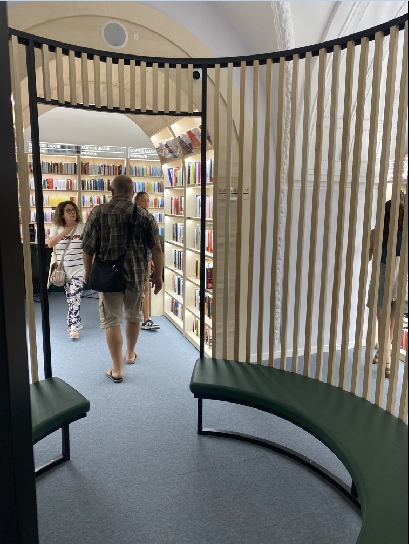
Inoltre la libreria ospita uno spazio dedicato alla musica e al cinema, un’area ristoro, uno, un po’ originale, dedicato alle enodegustazioni e quello esclusivo riservato agli eventi dove poter ospitare ospiti illustri. Lo stabile dedica all’arte e alla fotografia contemporanea un’area dove giovani talenti emergenti hanno la possibilità di poter esporre i propri lavori nel cuore della galleria. Alle pareti attualmente le immagini di Metamorfosi napoletane realizzate da quattro fotografi: Michele De Cesare, Gerardo Massaro, Fabio Monk e Davide Orfeo.
C’è la possibilità di avere un servizio che permette al cliente di acquistare online sul sito della libreria e ritirare in negozio e la funzione Trovalibro, che offre la possibilità di individuare la posizione del testo desiderato tra quelli disponibili nel negozio, agevolando l’esperienza del lettore in libreria.
« Napoli è la città ideale per ospitare una delle librerie più grandi d’Italia eco … perché da sempre luogo di cultura», dichiara Nello Nunziata, Responsabile della Divisione Sviluppo dei punti vendita.
Ogni libreria è un luogo del racconto dove tutti gli uomini che hanno riportato attraverso dei segni su un supporto il frutto del loro pensiero hanno dignità di cittadinanza. Una libreria è sempre la benvenuta in una comunità perché tempio della conoscenza, dell’inclusione, della tolleranza, del rispetto, delle ragioni dell’altro, insomma delle risorse immateriali che come l’energia sono il motore del mondo. Se non si rispettano queste condizioni è un negozio dove le parole non fluttuano leggere nell’aria ma sono nubi minacciose che turbano il clima e rendono l’aria mefitica.
Nel mio paese negli anni 60 c’era un uomo che veniva considerato una specie di mostro sia per l’aspetto fisico dovute alle deformità del volto e del corpo che per il carattere in alcune occasioni particolarmente aggressivo. Poverissimo, viveva in una baracca in mezzo alla campagna e aveva per letto un fascio di erba secca. In effetti era stato adottato dalla comunità che si adoperava per procurargli il cibo ma spesso, per stuzzicarlo, lo faceva in malo modo come quello di farglielo trovare in una scodella sporca utilizzata dai cani scatenando la sua ira.
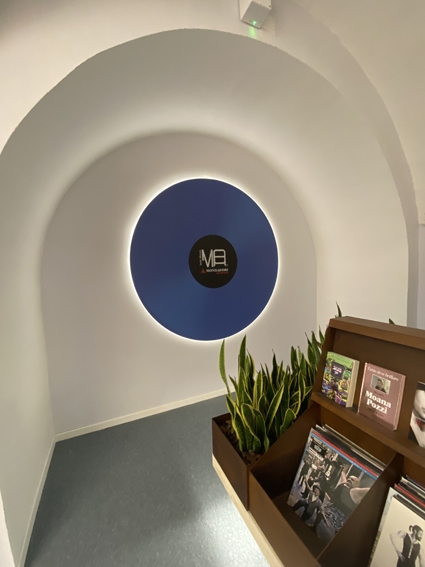
Aveva sempre sul petto una borsa e quando qualcuno tentava di strappargliela diventava furibondo. Sul contenuto di quella borsa si erano fatto le ipotesi più varie: un tesoro di oro, diamanti e perle, documenti che certificassero la sua origine o le tante proprietà che poteva avere.
Quando morì, una vecchietta che era andata ad accudirlo saltuariamente mentre era immobilizzato sul suo giaciglio, a cui era stato chiesto cosa avesse in quella borsa, che per lui era così preziosa, spiegò che era un libro di storie e favole per bambini. Negli ultimi giorni quando non riusciva più a vedere e il dolore diventava insopportabile le chiedeva di leggergliene una: riusciva a calmarlo e renderlo sereno. Prima di morire le chiese di mettere il libro sul suo cuore voleva portarlo con lui perché voleva che lo accompagnasse nell’al di là dove si trovava il mondo delle sue storie. Il miracolo della lettura.
@Riproduzione riservata
Per saperne di più
Read more at
https://www.mondadoristore.it/negozi/punti-vendita/Mondadori-Bookstore-Napoli-Umberto-I/40602/
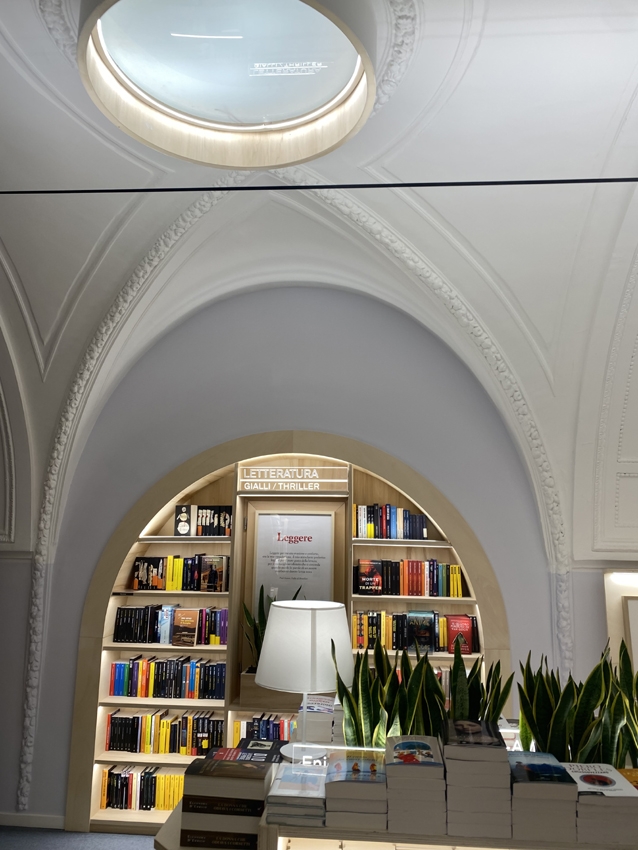
Inauguration/ Mondadori bookstore opens in Naples: there is also space for cinema, art and photography
The inauguration of the Mondadori bookstore is an eagerly awaited event in the city, after the opening on May 17th was followed by the closing on the 18th because not all the necessary permits were in place. Finally, after two months, the necessary permits have been obtained and the new opening is set for August 5th at 10:30 a.m. I am a little hesitant to attend the event, then with a phone call my friend Gianni pushes me to go.
When I arrive, waiting for the red ribbon to be cut on the front door, there are many people, mostly reporters and teleporters. The display case next to the front door allows a glimpse inside and the many books displayed near the glass, both those piled up in parallelepipeds by the same author and those arranged on a spiral staircase that rises slightly in the air.
The interior of the space is eye-catching and inviting, as are the books: their covers try to entice the reader to cross this passageway to travel between the pages.
When I look at the titles placed on the texts exhibited, I think of the wonder of this discovery: a representation of language through signs that allows us to understand for the reader the intentions of the writer. Even if the writer is gone and part of the past, the written word plays an essential role in knowing his or her thoughts and understanding the past in which he or she lived. These marks are a relationship that connects us to the past, but also a link that documents our history.
At other times, words, more than documenting facts or events, stimulate the imagination to give us dreams or evoke emotions. How many things are preserved in these mysterious chests that are books capable of building special worlds much more articulate than the most complex virtual reconstructions.
I recently read that it only takes 7 seconds to persuade an interlocutor because, according to this study, the information transmitted to our brain is visual in nature and images are processed in our brain 60,000 times faster than words. I don’t know if this is one of the main reasons why people today prefer pictures to reading. Certainly, when we turn away from the written word, we cannot even read pictures: we end up flipping through pictures quickly and dwelling on the ones that manage to catch our attention.
Reading is tiring, and often some sites, in order to attract us to the text, include the minutes needed to read it, as if there were a definite time in the relationship that each of us has with a piece of literature.
The problem that probably characterizes our age is the feeling of not having time. In this way we do not live the present moment and, without realizing it, we lose the possibility of experiencing our time.
We are almost an hour past the scheduled opening time, and with the arrival of Mayor Gaetano Manfredi, we can finally proceed with the opening. The Mondadori bookstore in the Umberto Gallery has a surface area of 1,000 square meters and a selection of 148,000 volumes.
There are fiction and non-fiction books, as well as many sections such as the one dedicated to children’s books, with educational games and illustrated fairy tales to stimulate the imagination of young children, or the innovative section dedicated to the phenomenon of manga and comic books.
The bookstore also has a space dedicated to music and cinema, a refreshment area, an original one for tasting wines, and an exclusive room for hosting important guests. The facility has a space dedicated to contemporary art and photography, where young emerging talents have the opportunity to exhibit their work in the heart of the gallery. On the walls are at the moment the images of Neapolitan Metamorphoses by four photographers: Michele De Cesare, Gerardo Massaro, Fabio Monk and Davide Orfeo.
There is also a service that allows customers to buy online from the bookshop’s website and pick it up in the store, and the Trovalibro function, which offers the possibility of locating the position of the desired text among those available in the store, facilitating the reader’s experience in the bookshop.
” Naples is the ideal city to host one of the largest eco-bookstores in Italy… because it has always been a place of culture,” says Nello Nunziata, Head of Store Development Division.
Every bookstore is a place of storytelling, where people who have brought back the fruit of their thinking through signs on a medium have the dignity of citizenship. A bookstore is always welcome in a community because it is a temple of knowledge, of inclusion, of tolerance, of respect, of the reasons of the other, in short, of the intangible resources that, like energy, are the engine of the world. If these conditions are not met, it is a place where words do not float lightly in the air, but are ominous clouds that disturb the climate and make the air mephitic.
In my village, in the 1960s, there was a man who was considered a kind of monster, both because of his physical appearance, due to deformities in his face and body, and because of his character, which was sometimes particularly aggressive. Very poor, he lived in a hut in the middle of the countryside and had a bundle of dry grass for a bed. In fact, he was adopted by the community, which tried to give him food, but often, to spite him, they did it in a bad way, like letting him find it in a dirty bowl used by dogs, which made him angry.
The contents of the bag had been the subject of many speculations: a treasure of gold, diamonds and pearls, documents proving his origin, or the many properties he might have had.
When he died, an old woman who occasionally took care of him while he was immobilized in bed, when asked what he had in that bag that was so precious to him, explained that it was a book of stories and fairy tales for children. In his last days, when he could no longer see and the pain became unbearable, he asked her to read one to him; so, she was able to calm him down and make him serene. Before he died, he asked her to put the book on his heart, to take it with him, because he wanted it to accompany him to the other world, where the world of these stories was. The miracle of reading.


